
One of the advantages of having an Apple Mac computer is the speed which you get from it. However, just like Windows PC’s, Mac computers can lag and run really slow too. It could be from your MacBook getting older, or you simply downloading too many programs or apps. Worse yet, you may have some virus or malware. These 8 tips that will speed up your Mac, will show some quick and easy ways to reverse that.
1. Clear Your Desktop –
The amount of time it may take your computer to boot up can often times depend on your desktop. One reason for that is because your desktop, is the first screen which has to load each time you turn it on. If you keep your desktop clean, it can vastly help speeding it up. Try minimizing the number of icons located on your dock. Also, clear up any of the files which you are able to see as well. You can place these files in folders or delete them. By doing this, you will prevent your operating system from using too many additional system resources each time you start your Mac. For those using older Macs, this can help them free up memory as well.
Are you a Windows user? Then check out these Tips On Deleting Temporary Files On Windows XP or 7
2. Close Out Programs –
While some may find this too obvious, having programs that you are not using running, can slow down your Mac. Leaving too many programs running, can cause your computer to devote memory to them. In addition, CPU space you may want for the actual apps you are using, will be used by those programs instead. Do a right-click on the Dock and find the programs running. Select Quit and you should be good to go. You can also press Command-Tab which will bring up the App Switcher. From there, you can then hit Command-Q to close and quit all unused programs.
3. Manage Start-ups –
Many applications, will configured themselves to automatically start up each and every time you turn your computer on. Too often, many of them are not even needed, used by you, or the system. The bad thing about them is that they end up sucking up a lot of valuable resources. Those resources are needed by other programs you are actually using. Remove any of those applications you do not use too often. Simply go to System Preferences > System > Users & Groups > Login Items and then once there, un-check any applications you do not want or need, from the start up menu.
4. Add More Memory (RAM)
The amount of memory (RAM) you have on your computer is one of the most important factors for the speed of your Mac. Using too much of it, can immediately slow it down and may even cause it to crash. However, if you add more memory, you can take advantage of using more applications simultaneously. While the brand doesn’t really matter, you need to make sure that use the right type of memory that pertains to your MacBook model. You will be surprised to see how much faster your Mac will run once you add more Ram.
5. Clean Up Your Hard Drive –
One of the things which can drastically slow your Mac down is lack of space on your hard drive. Since the Mac operating system utilizes any free space as ‘virtual memory’, lack of space plays a key role. In simple terms, the less amount of free space you have on your Hard drive, the least amount of memory that your computer will have at its disposal. There are several ways to free up space on your Mac. You can always remove unwanted or rarely used programs and delete files. Also, you can purchase an external Hard Drive, or a larger one, in order to move things there.
6. Monitor Your Activity Monitor –
All of the processes using your system resources on your computer can be easily seen by opening up your Activity Monitor in the utilities folder. This tool can instantly show you all of the processes running on your Mac. Keep in mind that some of these cannot be closed, and some, you shouldn’t close anyway. Still, by monitoring the processes, you can see exactly what applications are using the most resources on your computer.
7. Replace Your Hard Drive –
Traditional spinning hard drives were once great. However, replacing it with a ‘solid-state drive or SSD, is by far one of the best ways to vastly improve the performance and speed of your Macbook; especially older ones. Before you panic, doing this is quite easy and does not take that much time or knowledge. Most SSD cost around $200. In the end, it will be well worth it though.
Don’t miss reading about these Social Media and Other File Sharing Dangers
8. Use Cleaning Utility Tools –
Just like keeping your house, or any place you live in clean is essential, so is cleaning your Macbook regularly. Temporary files and other issues, can clog up your system and make it run real slow. Using one of the many different cleaning utility tools available out there, can keep your system running smoothly. It can also optimize your system’s performance exceptionally well. You can use a multifunction utility tool such as OnyX or CleanMyMac.
